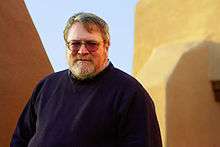Roger Jones (physicist)
Roger D. Jones (born 1953) is an American physicist and entrepreneur. He currently is a Research Fellow at the Center for Complex Systems and Enterprises at the Stevens Institute of Technology and a scientist with the X-Center Network.[1]
Roger D. Jones | |
|---|---|
 Roger D. Jones | |
| Born | 1953 California, USA |
| Nationality | United States |
| Alma mater | University of Florida (BS) Dartmouth College (PhD) |
| Scientific career | |
| Fields | Physics Extreme Events Adaptive Computation and Machine Learning Healthcare analytics Banking and Finance Origins of Life Self-Organizing Complex Systems |
| Institutions | X-Events Dynamics LLC (Co-Founder) Center for Complex Systems and Enterprises, Stevens Institute of Technology |
Scientific Interests
Jones, trained in physics at Dartmouth College, worked as a staff physicist at Los Alamos National Laboratory from 1979 to 1995. His primary research interests were in laser fusion and machine learning.[2] Jones's current interests are in extreme social events, biological signaling systems, serious gaming, and complex systems.
Startups
Jones, along with other Santa Fe scientists and entrepreneurs such as Doyne Farmer, Norman Packard, Stuart Kauffman, John Casti, and David Weininger, founded several high-technology startup companies in the emerging Santa Fe technology community, dubbed by Wired Magazine as the "Info Mesa".[3][4] Much of the effort of these startups focused on finance and the catastrophic reinsurance industry.[5][6] A later successful startup, Qforma, focused on healthcare analytics.
Center for Adaptive Systems Applications
The Center for Adaptive Systems Applications (CASA) was a company founded in 1995 by Jones, together with physicists Robert Stellingwerf, Camilo Gomez, and Stephen Coggeshall and business developer John Davies from Los Alamos National Laboratory[7] in collaboration with Citibank. The company applied neural network and adaptive technology to consumer banking.[8] The company was one of several companies that spun off from Los Alamos and the Santa Fe Institute that focused on banking, finance, and retail applications.
CASA applied machine learning, adaptive computation, and other data mining techniques to the prediction of customer behavior. The first applications were in consumer banking, specifically the prediction of personal bankruptcy and credit card delinquency for Citibank. The product offerings and projects expanded into smart agriculture, retail products, and management consulting.
The company was acquired by HNC Software in March 2000 at the peak of the dotcom boom.[9] HNC Software was subsequently acquired by Fair Isaac Corporation. Much of the technology developed at CASA became part of the credit scoring offerings of Fair Isaac.
Qforma
Qforma was founded in 2000 by Jones, pharmaceutical executive Kelly Myers, John Casti, and Robert MacDonald. The company, initially called CommodiCast, worked in the financial services sector. By 2006, the company switched to healthcare analytics. The flagship product was a social network that inferred the relationships among physicians in North America. The company merged with Skila Mederi in 2013.
Platform Economy
More recently, Jones has started companies in the transportation, real-estate, and book-publishing industries using the Platform-Economy model.[10] Platform companies are those that have little or no inventory, such as bookstores without books, taxi companies without cars, or hotels without rooms. Examples of platform companies are Amazon.com, Uber, and Airbnb. Jones co-founded X-Events Dynamics LLC[11] to focus on extreme events in business and government.
See also
References
- X-Center Network http://xcenternetwork.com
- Roger D. Jones (1993). "Machines that Learn" (PDF). Los Alamos Science. 21 (Special 50th Anniversary Edition): 195–203. Retrieved December 12, 2011.
- "Ed Regis, "Greetings from the Info Mesa," Wired Magazine, (June 2000) p. 337". Wired. January 4, 2009. Retrieved December 12, 2011.
- Regis, Edward (2003). The Info Mesa: Science, Business, and New Age Alchemy on the Santa Fe Plateau. New York: Norton. ISBN 0-393-02123-8.
- Mackenzie, Dana (February 1, 2002). "Dana MacKinzie, "The Science of Surprise," Discover Magazine, Vol. 23, No. 2, 59–63 (February 2002)". Discovermagazine.com. Retrieved December 12, 2011.
- "Kathleen Melymuka, "What if...?," Computer World News Story, February 4, 2002" (PDF). Archived from the original (PDF) on February 4, 2012. Retrieved December 12, 2011.
- Danneskiold, Jim (August 7, 1997). "Domenici dedicates new office for Los Alamos spinoff". Los Alamos, NM: Los Alamos National Laboratory. Archived from the original on November 3, 2008.
- Petzinger, Thomas (March 12, 1999). "Sometimes It Takes a Nuclear Scientist to Decode a Market". The Wall Street Journal. p. B1.
- Gallant, Steve (February 16, 2000). "HNC Software to Acquire the Center for Adaptive Systems Applications". KDnuggets. Retrieved April 23, 2015.
- Charles Colby and Kelly Bell, "The On-Demand Economy Is Growing, and Not Just for the Young and Wealthy," Harvard Business Review https://hbr.org/insight-center/the-platform-economy
- X-Events Dynamics LLC http://xed.world/